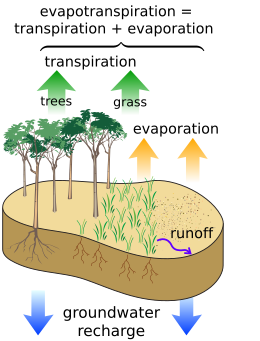Loss of water from a soil by evaporation or from plants by transpiration

Evapotranspiration (ET) is the sum of evaporation and plant transpiration from the Earth's land and ocean surface to the atmosphere. Evaporation accounts for the movement of water to the air from sources such as the soil, canopy interception, and waterbodies. Transpiration accounts for the movement of water within a plant and the subsequent loss of water as vapor through stomata in its leaves. Evapotranspiration is an important part of the water cycle. An element (such as a tree) that contributes to evapotranspiration can be called an evapotranspirator.
Potential evapotranspiration (PET) is a representation of the environmental demand for evapotranspiration and represents the evapotranspiration rate of a short green crop (grass), completely shading the ground, of uniform height and with adequate water status in the soil profile. It is a reflection of the energy available to evaporate water, and of the wind available to transport the water vapour from the ground up into the lower atmosphere. Often a value for the potential evapotranspiration is calculated at a nearby climatic station on a reference surface, conventionally short grass. This value is called the reference evapotranspiration (ET0). Actual evapotranspiration is said to equal potential evapotranspiration when there is ample water. Some US states utilize a full cover alfalfa reference crop that is 0.5 m in height, rather than the short green grass reference, due to the higher value of ET from the alfalfa reference.
